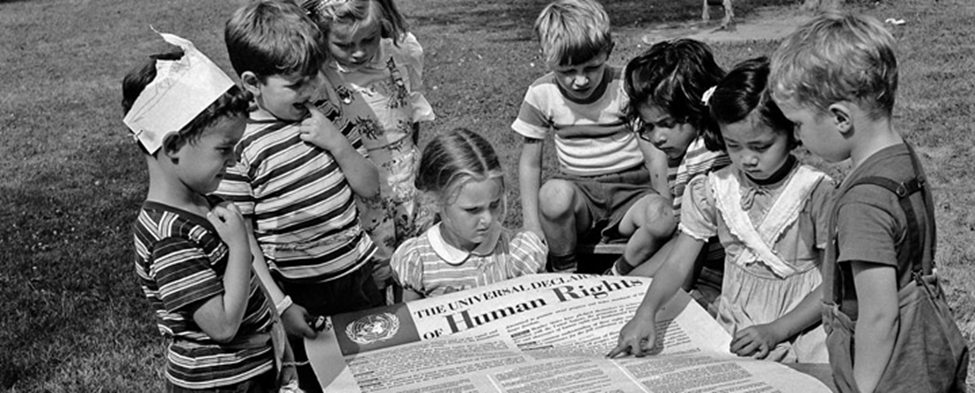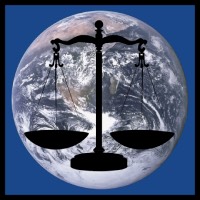The proposed Statute was unveiled at the 15th annual World Judiciary Summit in Lucknow, India in December 2014, and the urgent need for a World Court of Human Rights was expressly and unanimously included in the Chief Justices’ conference-concluding Resolution.


The Time is Now for the World Court of Human Rights
The World Court of Human Rights was born from the 1948 Universal Declaration of Human Rights, but no issue could be more pressing today. Groups such as Boko Haram and ISIS are committing unthinkable human rights violations, and there is currently no judicial mechanism by which to hold them accountable. The World Court of Human Rights will provide a forum for the adjudication of the individual claims, and of class action claims, arising out of large-scale human rights abuses. It will be the first judicial system to do so at the global level, and will positively impact the lives of millions and millions of the world’s most vulnerable men, women and children.
This is an idea has come through a careful process and a lengthy germination period:
-
The 1948 United Nations Universal Declaration of Human Rights was approved;
-
Early work by noted human rights attorney Luis Kutner, and by human rights activist Garry Davis, in the 1970s, led to the development of an early vision for the Court;
-
The Treaty of Lucknow, which underpins the Court, has received the full endorsement of the World’s Chief Justices; and
-
We are now in early talks with both the Indian Mission to the United Nations, and with the offices of several members of the United States Congress, with the goal of having those two countries, and many others, champion the establishment of the Court following the United Nations’ process.
An Invitation to Philanthropists and Justice Leaders:
Join Us in Establishing the
World Court of Human Rights
-
December 10, 1948 – The United Nations approves the Universal Declaration of Human Rights.
-
In the following decades, the United Nations treaty creation process gives birth to human rights treaties addressing: Civil & Political Rights; Economic, Social & Cultural Rights; Racial Equality; Women’s Rights, Children’s Rights; Indigenous Peoples’ Rights; and Migrant Workers’ Rights.
-
2014 – The proposed Statute of the World Court of Human Rights (The Treaty of Lucknow) is drafted through an international collaboration of judges, lawyers and scholars, and the Chief Justices of the World unanimously pass a Resolution endorsing the creation of the Court as an avenue of recourse for the voiceless.
-
2015 and 2016 – Information about the World Court of Human Rights will be broadly disseminated, widespread public awareness of the need will be promoted, grass roots support will be built, an Advisory Board will be formed, and the support of the members of the United Nations will be enlisted.
The Challenge
The United Nations, founded in the wake of World War II in 1945, has a strong focus on the universal protection of human rights, and has launched an era of international human rights institution-building and standard-setting.
An impressive United Nations human rights system has evolved over the past seven decades. During this period, under the framework of the Universal Declaration of Human Rights, the vast majority of the world’s nations have signed seven fundamental human rights treaties, protecting: Civil & Political Rights; Economic, Social & Cultural Rights, Racial Equality, Women’s Rights, Children’s Rights, Indigenous Peoples’ Rights, and Migrant Workers’ Rights. An independent Office of the High Commissioner for Human Rights exists to carry out human rights work within the United Nations on a global scale, and through a separate mechanism, an International Criminal Court has been established to prosecute individuals suspected of war crimes, genocide, and crimes against humanity.
The International Court of Justice is a place where countries can resolve treaty disputes, but does not provide a forum for individuals who are actively being deprived of their human rights…examples include 1.6 million Syrian refugees presently in camps in Lebanon, hundreds of Nigerian girls held captive by Boko Haram, persecuted Jews in Eastern Ukraine, and refugees in the Central African Republic. The list is very long, as there are 57 million refugees worldwide today.
There remains, however, a glaring gap in this impressive human rights architecture: a World Court of Human Rights. Humanity needs a judicial mechanism to provide enforceable and effective justice to individual and class-action victims of large-scale human rights violations.
Rights mean essentially nothing if there is no way to enforce them. United Nations charter-based and committee-based human rights systems are extremely valuable, but they are “intergovernmental” systems. They are not court-like in their nature, or in their operation. Just as nations states need an International Court of Justice to resolve their treaty disputes, victims of human rights violations need a World Court of Human Rights to which they can turn when governments either violate their rights, or act indifferently in the face of preventable suffering or discrimination. The United Nations’ intergovernmental human rights bodies cannot do it alone, and the right to judicial access is fundamental.
Through the adoption of human rights treaties over the past seven decades, the available remedies have expanded…in theory. Human rights standards are more widely known, better understood, and more universally accepted. The paradox is that the countries with the highest incidences of human rights violations often have governments with the least interest in fixing the problem. They also often have the least independent judiciaries. This is one factor in the emergence of the regional courts of human rights. The European Court of Human Rights is the closest regional example of what the World Court of Human Rights would be at a global level. Africa and the Americas have regional human rights systems as well, but they are somewhat more intergovernmental in nature. Asia, sadly, with 60% of the world’s population, and with more than its share of human rights problems, has no regional human rights system. Each of these regional human rights systems has evolved from a fundamental societal need, and the time has come to make the system procedurally and substantively uniform, and universally available.
The principle that the protection of human rights requires global judicial protection is not simply an abstract platitude. The need is compelling because the increasingly universal human rights standards that have evolved are so often honored more in their breach than in their observance. Fundamental principles of Rule of Law demand that the judiciary ensure that those whose human rights are violated have an effective means of recourse. The time is now to create a global human rights forum, and through that mechanism, to create a unified and coherent global human rights jurisprudence.With the establishment of a World Court of Human Rights, the last major piece will be in place for the realization of an effective and comprehensive international human rights system. This will enforce, and put into practice, the Universal Declaration of Human Rights, as developed by Eleanor Roosevelt and legions of other war-weary visionaries of that time.
The Proposal
The World Court of Human Rights will adjudicate selected, qualifying, human rights cases in which judicial review is sought by affected individuals and classes who are found by the Court to have standing. The cases which are accepted for adjudication by the Court will be decided in accordance with the United Nations human rights conventions, and their case law, all of which have evolved from the United Nations’ December 10, 1948 Universal Declaration of Human Rights. The cases before the Court will also be adjudicated in accordance with the broader body of regional human rights conventions, and their case law, and in accordance with generally accepted human rights custom, practice, jurisprudence and scholarship. The work of the Court will create and illuminate a consistent, cohesive and coherent body of substantive human rights law, through a uniform, comprehensive and efficient global judicial process. In so doing, the Court will promote worldwide awareness of, respect for, and compliance with the ever-growing world law of human rights.
The World Court of Human Rights Development Team, launched at the World Judiciary Summit in 2013, conducted a series of online meetings during the first half of 2014. The Development Team is composed of a mixture of judges, lawyers, academics, practitioners and nonprofits. The first task of the Development Team was to produce a proposed “Statute of the World Court of Human Rights,” using the statutes and practices of the International Court of Justice, the International Criminal Court, the European Court of Human Rights, the Inter-American Commission on Human Rights, and the African Commission on Human and Peoples’ Rights as guidance. Extensive research, discussion, drafting and editing took place over the course of the first six months of 2014.

Students at the United Nations International Nursery School in New York viewing
a poster honoring the adoption of the Universal Declaration of Human Rights.
Our goal is to catalyze and support the world’s nations in their adoption of the Treaty of Lucknow, and through that process, to actualize the World Court of Human Rights. There is ample precedent for the Court. The European, African and American regional human rights structures, as well as the many ad hoc human rights tribunals which have been convened in places like Southeastern Europe and Africa, bear eloquent witness to both the need for, and the feasibility of, such a global-level system. For the sake of 57 million refugees worldwide, what is desperately needed now is to standardize the international human rights judicial process, to make it universally available, and to produce a uniform body of human rights jurisprudence.
Join Us
We are well on our way to realizing the vision of a World Court of Human Rights. We have reached several important milestones over the past year, most notably gaining consensus for a World Court of Human Rights from the world’s Chief Justices, many of whom have pledged their personal and professional support for its creation. Our goal now is to see through the United Nations treaty adoption process during the balance of 2015 and 2016, and in order to do so, we need the support of the philanthropic community. Please join us in achieving this noble and imperative task.
The Peace Palace as Metaphor and Inspiration
The home of the International Court of Justice is in the Palais de la Paix (the Peace Palace), in The Hague. This graceful symbol of universal justice is depicted on the first page of this project overview. The Hague is often referred to as the seat of international law because it houses the International Court of Justice, the Permanent Court of Arbitration, the Hague Academy of International Law, and the extensive Peace Palace Library. The building was created in 1899 after The Hague Peace Conference. Andrew Dickson White, whose efforts were instrumental in creating the International Court of Justice, and in securing the funding to provide it with a “worthy accommodation,” wrote of the idea to his friend Andrew Carnegie, who in response, gave $1.5 million to build this remarkable structure. We seek to create a comparable site for the World Court of Human Rights, a fitting home for tireless efforts to protect and preserve the human rights to which all citizens of the world are entitled.
We seek the help of private philanthropy to help us in carrying the Treaty of Lucknow through to ratification. This is the critical next step. We hope to form a partnership with a foundation, philanthropist, or family interested in a significant act of generosity that is both lofty and tangible, both idealistic and fundamentally human.
We need to raise $250,000 in charitable contributions for this crucial next step. We ask you to consider carrying on the work of Andrew Carnegie, Eleanor Roosevelt and countless other courageous human rights advocates. We hope to be able to meet with you for the purpose of discussing an extraordinary project that will profoundly change the world.
Mark Oettinger, Project Director
David Gallup, Project Sponsor, World Service Authority
Paula Cope, Campaign Director
